| ________________
CM . . . . Volume XV Number 17. . . .April 17, 2009. 
 |
Estimation. (My Path to Math).
Penny Dowdy.
St. Catharines, ON: Crabtree, 2009.
24 pp., pbk. & hc., $7.95 (pbk.), $18.36 (hc.).
ISBN 978-0-7787-4355-2 (pbk.), ISBN 978-0-7787-4337-8 (RLB).
Subject Heading:
Estimation theory-Juvenile literature.
Grades 1-2 / Ages 6-7.
Review by Gail Hamilton.
*/4
|
| |
|

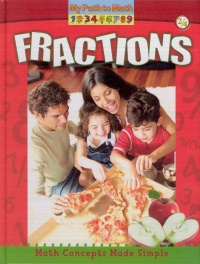 |
Fractions. (My Path to Math).
Penny Dowdy.
St. Catharines, ON: Crabtree, 2009.
24 pp., pbk. & hc., $7.95 (pbk.), $18.36 (hc.).
ISBN 978-0-7787-4356-9 (pbk.), ISBN 978-0-7787-4338-5 (RLB).
Subject Heading:
Fractions-Juvenile literature.
Grades 1-2 / Ages 6-7.
Review by Gail Hamilton.
*/4
|
| |
|

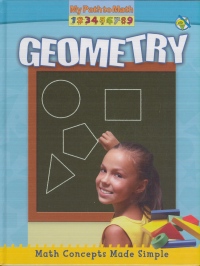 |
Geometry. (My Path to Math).
Penny Dowdy.
St. Catharines, ON: Crabtree, 2009.
24 pp., pbk. & hc., $7.95 (pbk.), $18.36 (hc.).
ISBN 978-0-7787-4358-3 (pbk.), ISBN 978-0-7787-4340-8 (RLB).
Subject Heading:
Geometry-Juvenile literature.
Grades 1-2 / Ages 6-7.
Review by Gail Hamilton.
*/4
|
| |
|

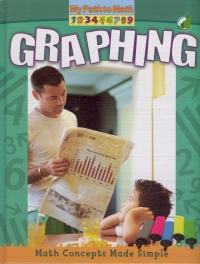 |
Graphing. (My Path to Math).
Penny Dowdy.
St. Catharines, ON: Crabtree, 2009.
24 pp., pbk. & hc., $7.95 (pbk.), $18.36 (hc.).
ISBN 978-0-7787-4357-6 (pbk.), ISBN 978-0-7787-4339-2 (RLB).
Subject Heading:
Graphic methods-Juvenile literature.
Grades 1-2 / Ages 6-7.
Review by Gail Hamilton.
*/4
|
| |
|

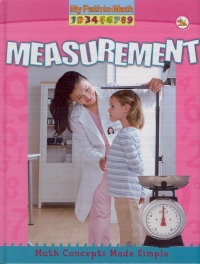 |
Measurement. (My Path to Math).
Penny Dowdy.
St. Catharines, ON: Crabtree, 2009.
24 pp., pbk. & hc., $7.95 (pbk.), $18.36 (hc.).
ISBN 978-0-7787-4359-0 (pbk.), ISBN 978-0-7787-4341-5 (RLB).
Subject Heading:
Measurement-Juvenile literature.
Grades 1-2 / Ages 6-7.
Review by Gail Hamilton.
*/4
|
| |
|

 |
Money. (My Path to Math).
Penny Dowdy.
St. Catharines, ON: Crabtree, 2009.
24 pp., pbk. & hc., $7.95 (pbk.), $18.36 (hc.).
ISBN 978-0-7787-4360-6 (pbk.), ISBN 978-0-7787-4342-2 (RLB).
Subject Headings:
Counting-Juvenile literature.
Money-Juvenile literature.
Grades 1-2 / Ages 6-7.
Review by Gail Hamilton.
*/4
|
| |
|

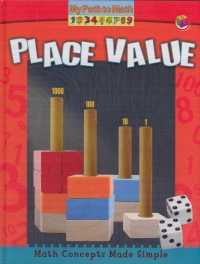 |
Place Value. (My Path to Math).
Penny Dowdy.
St. Catharines, ON: Crabtree, 2009.
24 pp., pbk. & hc., $7.95 (pbk.), $18.36 (hc.).
ISBN 978-0-7787-4361-3 (pbk.), ISBN 978-0-7787-4343-9 (RLB).
Subject Headings:
Place value (Mathematics)-Juvenile literature.
Counting-Juvenile literature.
Numeration-Juvenile literature.
Grades 1-2 / Ages 6-7.
Review by Gail Hamilton.
*/4
|
| |
|

 |
Time. (My Path to Math).
Penny Dowdy.
St. Catharines, ON: Crabtree, 2009.
24 pp., pbk. & hc., $7.95 (pbk.), $18.36 (hc.).
ISBN 978-0-7787-4361-3 (pbk.), ISBN 978-0-7787-4343-9 (RLB).
Subject Headings:
Time-Juvenile literature.
Grades 1-2 / Ages 6-7.
Review by Gail Hamilton.
*/4
|
| |
|

excerpt:
Look at the numbers 34 and 41. Compare them. What numbers are in the tens places? You are right: 3 and 4!
Is 3 or 4 bigger? That’s right: 4. So 41 is bigger than 34. It does not matter what number of ones are left over. Four tens are more than three tens. You do not need to count if you compare tens. (From Place Value.)
Designed for young learners, these titles comprise the “My Path to Math” series, touted as “math concepts made simple.” The books’ vibrant, colourful covers will appeal to children, though a few of the cover photos are a bit misleading and confusing. For instance, the cover of Place Value shows stacked blocks with 1000, 100, 10 and 1, yet the examples of place value in the book only go as far as the tens place. Each of the titles consists of nine chapters, plus a table of contents, a glossary and an index. The text is printed in a large, simple font with plenty of space around it. An “Activity Box” feature asks a question about the photo (e.g. How many cones are in the picture?) or about a related topic in the reader’s daily life (e.g. Where are the prisms in your home and school?). Illustrations, consisting of bright colour photographs and diagrams, are well suited to the text. One positive aspect of the photos is that they include people of all races and show males and females in non-traditional roles.
Despite the books’ simple vocabulary, they require the assistance of an adult - a parent or teacher - in order for the reader to make the most sense out of the concepts. To read the book from start to finish without stopping does not allow the child to fully grasp the math concepts presented. Some of the activities are a bit unrealistic: for example, how many kids will have 25 erasers at home to complete the estimation activity? And, with only 24 pages, including the glossary and the index, these books are overpriced. There is a lot of wasted space- there are only nine entries in the Estimation glossary, for example, yet the glossary takes up a double-page spread. Finally, there is a definite American slant, as the bills and coins shown in the photos in Money are mostly U.S. currency, and the metric system takes a back seat to the Imperial system in Measurement. Perhaps this is due to the author’s and/or publisher’s trying to capitalize on the larger American market.
Estimation features a young girl, Sima, who wants to win some art supplies in a contest, and, in order to do so, she must guess how many erasers are in a glass jar. Sima goes home to try to figure out the answer, but her experiment is not only somewhat unrealistic but also too convoluted for small children to understand. The terms exact, estimate, reasonable guess, model and chunking are defined.
Fractions covers simple fractions- halves, thirds and quarters- and describes fractions as equal parts of a whole or parts of a collection of things. The terms numerator and denominator are explained. In this title, a mother is preparing fruit salad and is dividing the ingredients into equal portions. The left facing page shows the whole fruit while the right facing page shows the parts, with a dotted circle drawn around the portion of the fruit that depicts the featured fraction. One concern with regard to the photos is that some of the fruits are shown sliced horizontally, and therefore, not all of the pieces are equal in size.
In Geometry, readers will learn about lines, circles, triangles, squares and rectangles as well as solid figures- spheres, cones, pyramids, prisms and cubes. Photos show examples from everyday life.
Graphing follows Miguel as he surveys garden centre shoppers, gathering data and recording it. From his data, he creates a pictograph. Surveying more shoppers regarding different purchases, Miguel then makes a bar graph and a Venn diagram. This book has several weaknesses: there is no mention of the term “tally” nor are there tally strokes shown; one of the photos is slightly mislabeled; there is a waste of space in repeating the same graph twice in the text; and there is no mention of line graphs, yet the large diagram on the glossary page and the tiny icon on every page clearly shows a line graph.
Measurement features linear measurement, mass and capacity. Readers might find the very brief information in this title confusing as it describes Metric and Imperial measure.
Children will learn about the various denominations of coins and bills in Money. The focus is on American currency, but even the photographs of the paper money are slightly washed out, giving an inaccurate depiction of the colour of the bills. This title explains how to write amounts of money in dollars and cents, shows how to skip count coins, and provides examples of equivalents (e.g. 4 quarters = one dollar). The one feature lacking is a description of what information and symbols appear on money.
Place Value highlights counting and skip counting as well as the “greater than” and “less than” symbols. Children will learn only the tens and ones places in this title.
Time features the difference between clocks and watches, the parts of a clock- the hour, minute and second hands- parts of the day and a calendar. The terms leap year, tomorrow, yesterday, today, morning, afternoon and night are introduced.
Though the concepts presented in these titles are important, there are several weaknesses in the text that need to be addressed in order for the series to have merit.
Not Recommended.
Gail Hamilton is a teacher-librarian in Winnipeg, MB.

To comment on this title or this review, send mail to
cm@umanitoba.ca.
Copyright © the Manitoba Library Association. Reproduction for personal use is permitted only if this copyright notice is maintained. Any other reproduction is prohibited without permission.
NEXT REVIEW |
TABLE OF CONTENTS FOR THIS ISSUE- April 17, 2009.
AUTHORS |
TITLES |
MEDIA REVIEWS |
PROFILES |
BACK ISSUES |
SEARCH |
CMARCHIVE |
HOME |







